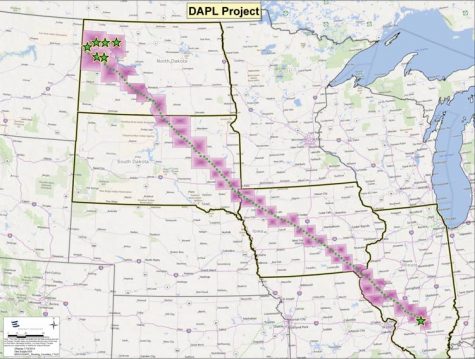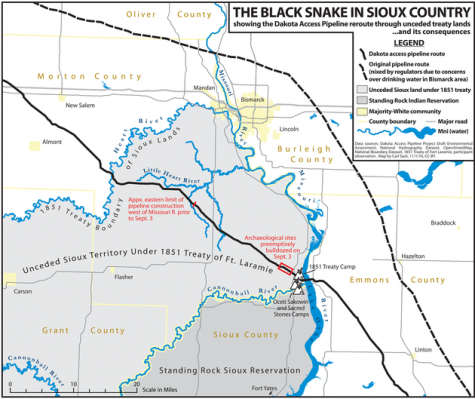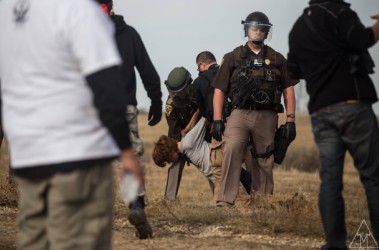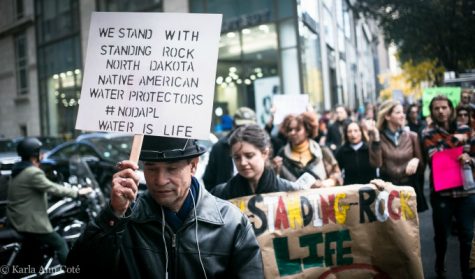What the DAPL is and Why You Should Care
November 10, 2016
You wake up, turn the faucet to wash your face, and instantly you see the stream of water flooded with oil.
Not something you want to see at 6 am?
Neither do the people at the Standing Rock Sioux reservation in South Dakota.
On January 25, 2016, the U.S Army Corps of Engineering approved the permit to construct the Dakota Access Pipeline, a 1,172 mile pipeline used to carry crude oil. The pipeline is estimated to carry some 470,000 gallons of oil a day from North Dakota, through South Dakota and Iowa, to Illinois. The Dakota Access Pipeline’s official website, http://www.daplpipelinefacts.com/, explains all of its intentions. According to the site, “We need to close the gap between what we produce as a country and what we consume before we can be truly independent of foreign imports.” They say the construction will produce $156 million in sales and income taxes combined. The site also says that it will “…generate an estimated $55 million annually in property taxes – for services to support schools, roads, emergency services and more.”
Here’s the problem: it’s dangerous.
Even though the engineers say it’s the safest way to carry crude oil, pipelines have burst in the past, creating contaminated water for many people and making a bigger problem than it solved. In Alabama, a pipeline carrying oil exploded on October 31, resulting in one casualty and five others injured.
The pipeline’s path is set to go through 4 states, all in the Midwest, shown below.

What the map doesn’t show you is that the pipeline goes through the Standing Rock Sioux reservation.

It is planned to go under the Heart River, Little Heart River, and Missouri River. Both Heart rivers are used for the reservation’s water supply, which can be potentially contaminated with the bursting of the pipeline.
Protests against the pipeline started late July when the attorneys that represent the Standing Rock Sioux Tribe filed a complaint against the U.S. Army Corps of Engineers.
In those first few days, 141 protesters were arrested.
In August, the UN showed its support for the movement.
Leaders stated “…The environment is an important part of our lives and any threats to it impacts our families, ancestors and future generations. It is therefore imperative that the United States respects and recognizes the intrinsic, inter-related rights of Sioux and their spiritual traditions, history, philosophy, and especially their rights to their lands and territories. The world is watching what is happening in North Dakota.”
In early September, the police involvement in the decreasing of protesters increased. Protesters reported pit bulls and pepper spray were used on men, women and children. There were 30 protesters hit with the spray and 12 bitten by dogs.
The Chairman of the Standing Rock Sioux Tribe, Dave Archambault II, spoke up about the matter.

“…Today we have witnessed people praying in peace, yet attacked with pepper spray, rubber bullets, sound and concussion cannons,” said Archambault.
Young activists on Twitter and many other social media sites voiced their opinion in the matter through the hashtags #NoDAPL and #RezpectOurWater.
Last Thursday, I had the opportunity to see Jon Meacham, a highly respected and sought after presidential historian, speak, with the Susky History Club. He has been featured on CNN, MSNBC, and many other national news organizations, especially during this election.
I asked him about the similarities between the Dakota Access Pipeline and the Native Removal Act of 1830. He said he didn’t know what the pipeline was. I explained the basics to him, then he responded with a well explained answer.
“I don’t know anything about it,”Meacham stated. “But one of the questions we always have to ask is when we’re undertaking large national projects, is to what extent are we respecting, or conversely trampling upon, the rights of minorities, potentially for the good of the majority? One of the fundamental American questions is how do you
 balance majority-minority interests? Does the majority always rule? It’s not supposed to. A government of laws is supposed to protect minorities from the tyranny of a majority. It seems to me, from what you described, is that there is a risk that the interests of a not particularly well organized or well connected minority might be harmed by the interests of a better organized and more powerful interest.”
balance majority-minority interests? Does the majority always rule? It’s not supposed to. A government of laws is supposed to protect minorities from the tyranny of a majority. It seems to me, from what you described, is that there is a risk that the interests of a not particularly well organized or well connected minority might be harmed by the interests of a better organized and more powerful interest.”
We as Americans need to realize and understand that the interests of the minority of Native Americans are being trampled upon. We need to support the protesters in their activism and valor for traveling to the reservation and putting up a fight.
If you would like to help the protesters but cannot fly to South Dakota to protest along with them, go to http://thefreethoughtproject.com/10-protest-dakota-access-pipeline/ to donate and learn more about petitions to stop the Dakota Access Pipeline.
Information and photos used in this article are from the following sources:
http://abcnews.go.com/US/timeline-dakota-access-pipeline-protests/story?id=43131355
http://www.daplpipelinefacts.com/
http://abcnews.go.com/US/tensions-mount-protesters-police-controversial-pipeline/story?id=43078902
https://twitter.com/wesenzinna/status/792066234082746368
https://twitter.com/canativeobt/status/791875093324410880
http://www.huffingtonpost.com/entry/a-nodapl-map_us_581a0623e4b014443087af35?




